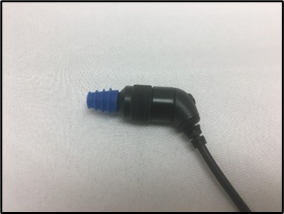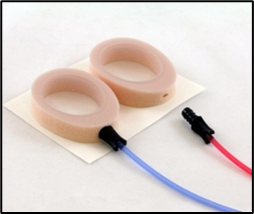Automated ABR equipment for newborn hearing screening often have different transducer options for delivering the stimulus to the baby’s ear. There are pros and cons of each because the transducer type will directly affect the cost to perform each screening, the test set up procedure, training, and the equipment maintenance. With the GSI Novus, the three transducer options for screening are the OAE probe, insert earphones with OAE tips, and insert earphones with EarCups. While not all brands of AABR equipment have three transducer choices, the general pros and cons of each still apply.
AABR SCREENING WITH OAE PROBE
There are multiple benefits of screening with the OAE probe. The most compelling is the low cost of screening supplies. Cost per screen is often a deciding factor when selecting an AABR device because the cost of supplies over a 5-year period will often well exceed the cost of the actual screening device. The cost is low when screening with the OAE probe because other than the 3 electrodes, only 1 or 2 OAE eartips are needed.

Another benefit includes being able to perform both AABR screening and OAE screening with the same transducer and the same device in facilities that perform both types of screening. Either test can be performed without having to physically change the transducer between test types. This reduces wear and tear on the connectors because the probe remains attached to the screening device for both tests. Using one transducer also reduces the amount of training needed for screening personnel because placing a OAE tip on the probe and inserting it into the baby’s ear is the same for both tests.
There are a few drawbacks to AABR screening with the OAE probe. With the probe, AABR testing is completed one ear at a time. The baby usually must be turned over or head turned to the side between ears so the probe can be seated properly in the test ear. This may disturb a sleeping baby and prolong the test time. In addition, inserting the probe tip into a baby’s ear can be daunting when the hearing screeners are non-medical personnel. Finally, the probe tip must be cleaned regularly to remove vernix or debris that builds up and could block the sound.
AABR SCREENING WITH INSERT EARPHONES AND OAE TIPS
The cost per screen with insert earphones and OAE tips is very similar to screening with the OAE probe with only 2 eartips needed in addition to the electrodes. A special adapter designed to fit OAE tips is provided with the insert earphones. It is possible to perform AABR testing in both ears simultaneously which may reduce overall test times. Low costs and ability to perform binaural testing is often a reason for selecting this method of AABR testing.

One drawback to screening with inserts and OAE tips is the adaptors, due to their length, protrude from the ear and may easily pop out if the baby moves during the screening. In addition, if a facility performs both AABR and OAE screens, the probe and inserts must be physically changed between tests. Frequent switching between transducer cables can increase wear and tear on the connectors. Finally, like the OAE probe, the clear eartip adaptors may become blocked with vernix and must be replaced on a regular basis because it is not possible to clean them.
AABR SCREENING WITH EARCUPS
Utilizing insert earphones with EarCups for screening has many benefits. They are held in place with adhesive or hydrogel, are designed to adhere to the baby’s skin for the duration of the AABR screening and usually will not pop off if the baby moves during testing. The earcups cover both ears entirely with one size fitting all making it easy to train screeners. Because they fit over the ear, nothing needs to be inserted into the ear canal. Finally, EarCups allow for binaural testing.

The major drawback of AABR screening with EarCups is the cost. Depending on the brand of equipment, the cost of one pair EarCups with electrodes can be as high as $15.00 per screening. Depending on the number of births per year, the costs can add up quickly. The table below shows an example of the impact the transducer used for AABR has on the yearly costs. Inserts with EarCups far exceeds the other options.
| AABR Transducer |
Supplies Needed |
Cost Per 1 Baby* |
Cost Per 500 Babies/1 Year |
Cost Per 500 Babies/5 Years |
| OAE Probe |
Electrodes + OAE Tip |
$2.00 |
$1,000.00 |
$5,000.00 |
| Inserts with OAE Tips |
Electrodes + 2 OAE Tips |
$2.50 |
$1,250.00 |
$6,250.00 |
| Inserts with EarCups |
Electrodes + EarCups |
$10.00 |
$5,000.00 |
$25,000.00 |
| *Individual costs are approximate |
Other than cost, the hearing screeners need to be well trained to ensure that the earcup completely seals around the ear ensuring there are no gaps. When the cup pulls away from the skin, the sound leaks out which reduces the intensity of the stimulus and potentially causing a refer result. In addition, if a facility performs both AABR and OAE screens, the probe and inserts must be physically changed between test types increasing wear and tear on connectors.
SUMMARY
In summary, there are multiple transducers that can be used to perform AABR hearing screening. Each transducer has pros and cons that impact the screening process and training of screening personnel. Below is a general summary of the benefits of each.
| TRANSDUCER OPTIONS FOR AABR SCREENING |
| AABR Transducer |
Cost Per Screen |
Binaural Testing |
Performs AABR and OAE |
| OAE Probe |
Lowest |
No |
Yes |
| Inserts with OAE Tips |
Low |
Yes |
No |
| Inserts with EarCups |
Highest |
Yes |
No |
Karen received her master's degree in audiology from Purdue University. She has an extensive clinical background that includes evoked potentials, vestibular assessment and hearing aid fittings. For over 10 years, she has worked in the industry in a variety of roles including customer support for an evoked potential manufacturer and as the Manager of Audiology Education for a large international equipment company. At GSI, Karen divides her time between application support for customers and distributors and product management. Prices in this blog are accurate as of 5/10/2023.